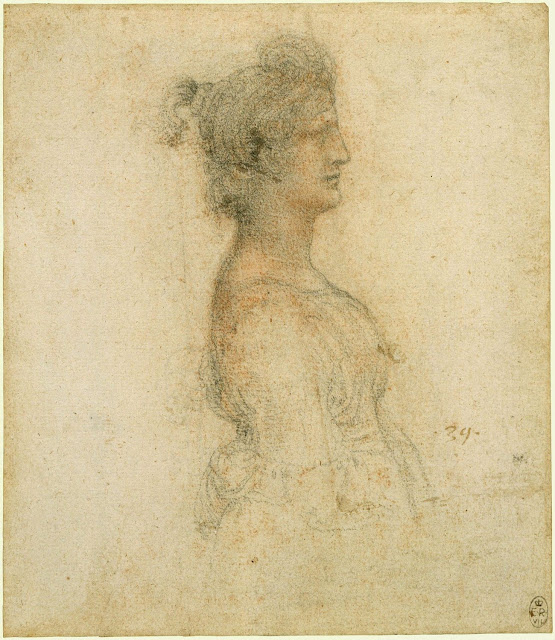 |
| Michelangelo Studies for Holy Family 1505 drawing Kupferstichkabinett, Berlin |
 |
| Andrea Mantegna Triumph of Senators before 1506 drawing Phillips Collection, Washington DC |
"The artist alone is the creator of the rules and rules exist just so far and are just so many as there are artists."
– Giordano Bruno (1548-1600), quoted by Walter Friedlaender in Mannerism and Anti-Mannerism in Italian Painting (Columbia University Press, 1957)
 |
| Fra Bartolomeo Drapery-study for St Catherine 1511 drawing Kupferstichkabinett, Berlin |
 |
| Jacopo Pontormo Figure-study for Visitation fresco ca. 1514-15 drawing Kupferstichkabinett, Berlin |
 |
| Leonardo da Vinci Bust of masquerader in profile ca. 1517-18 drawing Royal Collection, Windsor |
"A drawing of a woman, seen half length, in profile to the right. She wears a tight-fitting bodice, and an elaborate pseudo-classical headdress. The figure has a high-waisted dress and pronounced bust and must be female, though the convergence of male and female to a single ideal type is a marked aspect of Leonardo's late work. The hair is wound around the head and knotted, with a tail emerging from the knot, and dressed at the front into a shell-like crest. In concept this is closer to the ideal heads of Michelangelo and the mannerists of the Florentine and Fontainebleau schools than to Leonardo's earlier drawings such as the Leda studies. . . . Provenance: Bequeathed to Francesco Melzi, from whose heirs purchased by Pompeo Leoni, ca. 1582-90. Thomas Howard, 2nd Earl of Arundel, by 1630. Probably acquired by Charles II; Royal Collection by 1690."
– curator's notes from the Royal Collection
 |
| Raphael Figure of kneeling woman 1518 drawing National Gallery of Scotland, Edinburgh |
 |
| Bartolomeo Montagna Study for Christ enthroned ca. 1520 drawing Royal Collection, Windsor |
 |
| Andrea del Sarto Study of a Youth and Study of a Bust of Homer 1520-21 drawing Kupferstichkabinett, Berlin |
"During the siege of Florence some captains had fled the city with the pay-chests; on which account Andrea [del Sarto] was asked to paint on the façade of the Palace of the Podestà and in the Piazza not only those captains, but also some citizens who had fled and had been proclaimed outlaws. He said that he would do it; but in order not to acquire, like Andrea dal Castagno, the name of Andrea degl'Impiccati, he gave it out that he was entrusting the work to one of his assistants, called Bernardo del Buda. However, having made a great enclosure, which he himself entered and left by night, he executed those figures in such a manner that they appeared to be the men themselves, real and alive. The soldiers, who were painted on the façade of the old Mercatanzia in the Piazza, near the Condotta, were covered with whitewash many years ago, that they might be seen no longer; and the citizens, whom he painted enitrely with his own hand on the Palace of the Podestà, were destroyed in like manner."
– Giorgio Vasari, from the Life of Andrea del Sarto in Lives of the Painterts, Sculptors and Architects (1568) translated by Gaston du C. de Vere and published in English in 1912
 |
| Giovanni Francesco Penni Two Angels with Candelabrum ca. 1520-25 drawing Teylers Museum, Haarlem |
 |
| Rosso Fiorentino Seated youth ca. 1524 drawing British Museum |
 |
| Parmigianino Venus disarming Cupid ca. 1524-30 drawing Museum of Fine Arts, Budapest |
"The third among the creators and prototypes of the anticlassical mannerist style is not a Florentine but a north Italian. This is Francesco Parmigianino, born in 1503, and thus almost a decade younger than Pontormo and Rosso. Furthermore, he stems from a basically different artistic culture and thus contributes a different artistic pattern. For he did not have to struggle against the stability of Roman and Florentine High Renaissance art, and he had not, in his youth, absorbed like mother's milk the plastic anatomy of the bathing soldiers of Michelangelo. For him instead the grace and the optical subjectivism of Correggio had been the source in his decisive years, and he was himself inclined by his whole nature to increase and refine the delicacy and the courtly elegance of his master. Thus the transition to the new style is not nearly so rough and revolutionary in him as in the two Florentines. With these limitations in mind, one can say that the relataion of the developed art of Parmigianino to Correggio is in general the same as that of Pontormo and Rosso to Andrea del Sarto and the Florentine High Renaissance."
– Walter Friedlaender, from Mannerism and Anti-Mannerism in Italian Painting (Columbia University Press, 1957)
 |
| Perino del Vaga Sheet of sketches ca. 1525-45 drawing Teylers Museum, Haarlem |
 |
| Polidoro da Caravaggio Religious Procession ca. 1530 drawing Royal Collection, Windsor |
 |
| Pordenone Conversion of St Paul 1530 drawing Morgan Library, New York |
"Among other reasons that caused him [Pordenone] to give an incredible amount of effort to all his works, was his rivalry with the most excellent Tiziano; since, setting himself to compete with him, he hoped by means of continual study and by a bold and resolute method of working in fresco to wrest from the hands of Tiziano that sovereignty which he had gained with so many beautiful works; employing, also, unusual methods outside the field of art, such as that of being obliging and courteous and associating continually and of set purpose with great persons, making his interests universal, and taking a hand in everything. And, in truth, this rivalry was a great assistance for him, for it caused him to devote the greatest zeal and diligence in his power to all his works, so that they proved worthy of eternal praise."
– Giorgio Vasari, from the Life of Pontormo in Lives of the Painterts, Sculptors and Architects (1568) translated by Gaston du C. de Vere and published in English in 1912